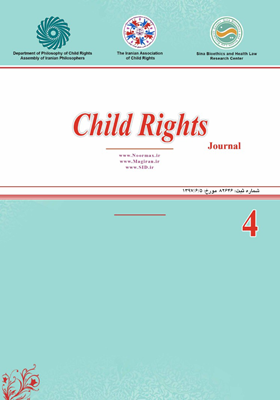مسؤولیت دولتها و ساز و كارهای صیانت از حقوق كودك در فضای مجازی
الموضوعات : child rights
1 - دانشیار و عضو هیأتعلمی دانشگاه عالی دفاع ملی، تهران، ایران
الکلمات المفتاحية: کودک, فضای مجازی, تهدیدات و آسیبهای سایبری, بزهکاری, اسناد بینالمللی,
ملخص المقالة :
توسعه روزافزون فضای سایبر و استفاده از فناوریهای ارتباطات و اطلاعاتی نقش مؤثری در تولید، انتشار و انتقال اطلاعات داشته و سطح دسترسی به محتوای برخط را برای آحاد جامعه فراهم ساخته است. از این رو فضای مجازی به عنوان یك ابزار توانمندساز قابلیت ترویج آزادیهای اساسی همچون آزادی بیان، آزادی دسترسی به اطلاعات را و وسیله مؤثر برای ارتقای حقوق بشر محسوب میگردد، اما در عین حال، شرایطی را فراهم میسازد تا در آن حقوق افراد نقض یا محدود گردد. در این میان حقوق كودكان به عنوان آسیبپذیرترین قشر جامعه معمولاً مورد تعرض و سوءاستفاده قرار میگیرد. در دنیای معاصر کودکان زمان زیادی را برای فعالیتهای آموزشی، تفریحی و سرگرمی در اینترنت و فضای مجازی سپری میکنند. در این فضا با توجه به گستردگی دامنه آن، مخفیبودن هویت کاربران، سرعت بالا، فرامرزیبودن، فقدان مکانیزم اعمال صلاحیت دولتها میتواند بر حوزه شناخت و ادراک کاربران تأثیر عمیقی گذاشته و افراد به خصوص کودکان و نوجوانان را با خطرات خاص مواجه نماید. از این رو حقوق كودك باید از سوی دولتها و سایر نهادهای دولتی و مدنی و سایر متولیان امور كودكان مورد حمایت و صیانت ویژه قرار گیرد. سؤال اصلی تحقیق این است که دولتها به موجب حقوق بینالملل عرفی و اسناد معتبر بینالمللی نسبت به حمایت از کودکان در فضای سایبر چه تعهدات سلبی و ایجابی دارند؟ چه ساز و کارهای فنی، قانونی و ساختاری را برای حمایت از کودکان را در برابر آسیبهای این فضا در دسترس است؟ رویه دولتها و نهادهای بینالمللی و جامعه مدنی در صیانت از حقوق کودک از یکسو و حفظ جریان آزاد اطلاعات و آزادی بیان چگونه بوده است؟ برای پاسخ به این سؤالات، محقق با استفاده از روش توصیفی به دنبال ارائه چارچوب منسجمی برای حمایت از کودکان در فضای مجازی میباشد.
1. Ghari Seyed Fatemi SM. Human Rights in the Contemporary World. Tehran: Institute of Legal Studies and Research of its Mayors; 2009. Vol.2 p.195.
2. Biparva A, RobatJazi MT. Protecting Children in Cyberspace in the Framework of Regional and International Documents. Tehran: First National Conference on Cybercrime: Challenges and Solutions; 2016. p.54.
3. UNCRC (United Nations Convention on the Rights of the Child). 1989.
4. Christopher De Bono C. Global research agenda for children's rights in the digital age. UNICEF East Asia and Pacific Regional Office, Bangkok. Journal of Children and Media 2013; 8(4): 317-335.
5. France, Information Systems Defense and Security: France’s Strategy. 2011. p.21.
6. Motamed Nejad K. UNESCO and Child Protection against the Internet. Media Mag 2001;46: 28-33.
7. Available at: https://www.unicef.org/sowc2017/.
8. Available at: https://rm.coe.int/guidelines-to-respect-protect-and-fulfil-the-rights-of-the-child-in-th/16808d881a.
9. Available at: https://www.researchgate.net/www.researchgate.net.
10. Chabakpour M. The role of the cyber environment in crime. Tehran: Faculty of Law and Political Science; 2014.
11. Didaban S. Criminological Investigation of Child Pornography. Tehran: School of Law and Political Science; 2014.
12. Islami I. Position of Protecting Victims of Cybercrime in Criminal Law and International Law. Journal of Law Islamic 2016; 1(43 Consecutive): 158-182.
13. Biparva A, Aamani SGH. Human and citizenship rights education by media. Modern Applied Science 2016; 9: 265.
14. Margaret AH. Child Pornography: An International Perspective. Stockholm: Computer Crime Research Center; 1998. p.135-152. Available at: http://www.crime-research.org/articles/536/. Visited at October 8, 2019.
15. ; 1998.
16. Hoskins E, Hick S, Helpin E. Human Rights and the Internet. Translated by Zamani SGH, Behramloo M. Tehran: Khorsandi Publications; 2007. p.240.
17. Calcetas-Santos. United Nations Special Rapporteur on the sale of children, child prostitution and child pornography, (1994-2001). Geneva: UNESCO; 1999. p.19.
18. Human rights guidelines for Internet Service Providers, Council of Europe Expert on Data Protection. 2014.
19. Human rights guidelines for online games providers, Council of Europe Expert on Data Protection. 2014.
20. Skoog DM. Innocence exploited: Child pornography in the electronic age. Ottawa: Canadian Police College; 1998. p.266.
21. Livingstone S. Knowledge enhancement: The risks and opportunities of evidence-based policy. Edited by O’Neill B, Staksrud E, Mc Laughlin S. Towards a Better Internet for Children? European Policy Pillars, Players and Paradoxes. Göteborg: Nordicom; 2013. p.93-109.


